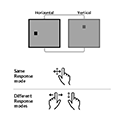Abstract
The present study investigated how response mode determines the specificity of control responsible for the congruency sequence effect (CSE), especially when conflict arises from spatial dimensions. Horizontal and vertical Simon tasks were presented in turn, while response mode (Experiment 1) or task-relevant stimulus dimension (Experiment 2) was manipulated. All responses were made by aimed movements to make the relative salience of the horizontal and vertical dimensions equivalent regardless of response mode. The confound-minimized CSEs were significant only when the two tasks shared the same response mode, which did not vary as a function of task-relevant stimulus dimension. This result suggests that response mode determines the scope of control, as it reconfigures the representations of the task-irrelevant spatial dimensions (i.e., the horizontal and vertical dimensions), which is corroborated by distributional analyses. This response mode-specific control was also consistently found for the horizontal and vertical arrow versions of flanker-compatibility tasks in Experiment 3, in which conflict does not directly arise from the response dimension. Furthermore, the current findings revealed that the CSEs were more evident in movement times than in initiation times, which provides new insight on how control inhibits the response activated by a task-irrelevant stimulus dimension, especially at a motor level.
